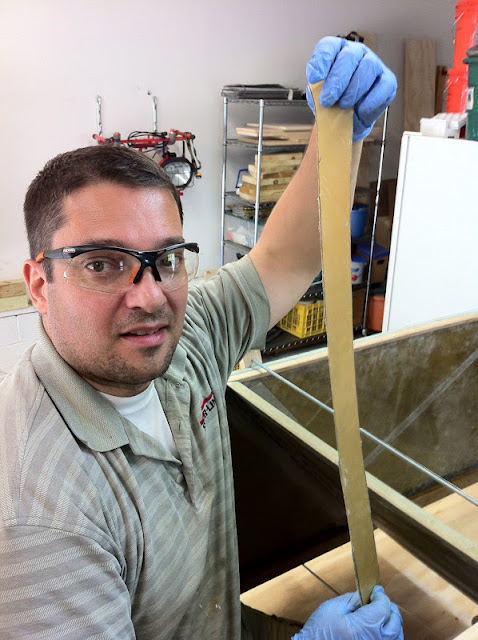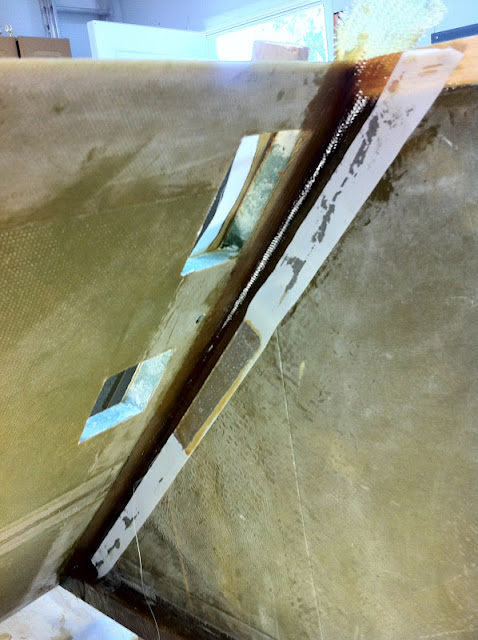Fuselage alignment and taping (14.0)
Wow, this has been a pretty frustrating experience!
In my mind, I would just put everything together and be done. Except for one little detail... everything need to be plumb, and square.
 |
| Front view of fuselage alignment goals |
 |
| Top view of fuselage squaring procedure |
Come on! How difficult could that be?
I knew I had used my very best effort to be as precise as possible, so I reasoned this cross-check would be pro-forma.
Little did I know that I’d be fiddling with this fuselage on and off for two weeks. No CNC matched hole technology here!
Things got so bad in-fact, that I eventually broke down and asked Eagle-eye Walter (of previous fame), to make a house call and help straighten my mess.
 |
| Note the black shim in front of F-22 (right side) |
 |
| Increasing stiffness while measuring the fuselage |
Eventually the fuselage came out pretty straight, but it took a lot of work, mostly because I couldn't figure out how to adjust it.
I still had a little more sanding to do at the bottom left of the front, and rear seats, to get a closer fit, but I couldn't get neither F-22 nor the firewall squared.
Also, the sidewalls by the front seat were out of plumb by half an inch or more.
Man, I just wanted to burn the darn thing!
I tried using pressure from both sides to change the shape slightly, by nailing blocks of wood to my table and shimming ever which way. Nothing!
Eventually, out of desperation, I started sliding one sidewall relative to the other, measuring again, and did get movement in the right direction. Still, I was shimming and measuring, over and over, for hours.
By the time Walter arrived the next day, his presence alone seemed enough to scare the fuselage straight, and even the sidewalls by the front seat became nearly perfectly plumb.
Sometime you just have to relinquish control to a higher authority.
I was very happy that my good friend Walter found the fuselage ready for “taping”, and that’s exactly what I did next.
First, I loosened up the apparatus holding the middle of the fuselage tight, then I mixed up some flox, put it in a ziplock bag, cut one of the corners, and used it as a pastry bag to deliver its load between the front seat and the sidewall. After tightening the contraption back up, some of the flox squeezed out the front and back. Using the made-up pastry bag, I squirted a long bead of flox in the long corner, then used a tongue depressor to shape it like a rounded corner.
 |
| Flox added to the intersection |
Flox alone is not enough to structurally join the bulkhead to the sidewall, fiberglass is needed to span the corner, and transfer the loads. As I’ve done in the past, I made some pre-preg strips of fiberglass to help reduce the mess, and make the job easier. This time I used two layers of 2” wide BID (5 cm) cut at 45˚. These are actually used so often during construction, that they have their own name: “BID tape” or “corner tape”.
 |
| I used two 29" long BID tapes |
BID tapes are applied to the structure like a giant band-aid. Remove one sheet of plastic, attach it in place, then peel the back sheet.
 |
| BID tape in place, before peeling the back plastic sheet. |
I was a bit apprehensive about this step because of all the compound curves involved. Bid tape will bend around corners somewhat, but after reading a Canard forum post, I knew how difficult it could become. In spite of that, it turned out to be one of the easiest things I’ve done so far. I just used a brush to stipple the BID tape in a few spots, and went right on to applying peel-ply.
 |
| Plastic backing removed, and peel-ply being added. |
 |
| Peel-ply applied |
 |
| Detail of lower compound corner |
 |
| Right back-side of front seat, taped. Fuselage is upside down, remember? |
 |
| Right front-side of front seat, taped. |
Because, I underestimated the amount of time it would take to finish the job, I barely had enough to finish one side before leaving on another trip.























